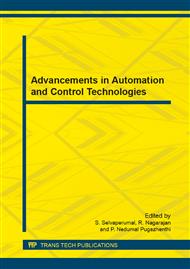[1]
K. Palanikumara, J. Paulo Davim. Assessment of some factors influencing tool wear on the machining of glass fibre-reinforced plastics by coated cemented carbide tools. Journal of materials processing technology. 209, 2009, 511–519.
DOI: 10.1016/j.jmatprotec.2008.02.020
Google Scholar
[2]
N. Muthukrishnan, J. Paulo Davim. Optimization of machining parameters of Al/SiC-MMC with ANOVA and ANN analysis. Journal of materials processing technology. 209, 2009, 225–232.
DOI: 10.1016/j.jmatprotec.2008.01.041
Google Scholar
[3]
I. Singh, N. Bhatnagar, P. Viswanath. Drilling of uni-directional glass fiber reinforced plastics: Experimental and finite element study. Materials and Design. 29, 2008, 546-553.
DOI: 10.1016/j.matdes.2007.01.029
Google Scholar
[4]
C.C. Tsao, H. Hocheng. Evaluation of thrust force and surface roughness in drilling composite material using Taguchi analysis and neural network. Journal of materials processing technology. 203, 2008, 342–348.
DOI: 10.1016/j.jmatprotec.2006.04.126
Google Scholar
[5]
Koenig W, Wulf C, Grass P, Willerscheid H. 1985. Machining of fiber reinforced plastics. Manufact Tech CIRP Ann. 34(2): 537–48.
DOI: 10.1016/s0007-8506(07)60186-3
Google Scholar
[6]
Yachida, M. and Tsuji, S. Industrial computer vision in Japan. Computer. 13, 1980, 50–63.
DOI: 10.1109/mc.1980.1653621
Google Scholar
[7]
M. Kiran, B. Ramamoorthy and V. Radhakrishnan. Evaluation of surface roughness by vision system. International Journal of Machine Tools & Manufacture. 38(5), 1998, 685–690.
DOI: 10.1016/s0890-6955(97)00118-1
Google Scholar
[8]
Du-Ming Tsai, Chi-Fong Tseng. Surface Roughness Classification for castings. Pattern Recognition. 32, 1999, 389-405.
DOI: 10.1016/s0031-3203(98)00077-6
Google Scholar
[9]
M. Gupta and S. Raman. Machine vision assisted characterization of machined surfaces. International Journal of Production Research. 39(4), 2001, 759–784.
DOI: 10.1080/00207540010011045
Google Scholar
[10]
S.Y. Ho, K. Lee, S. Chen and S.J. Ho. Accurate modeling and prediction of surface roughness by computer vision in turning operations using an adaptive neuro–fuzzy inference system. International Journal of Machine Tools & Manufacture. 42, 2002, 1441–1446.
DOI: 10.1016/s0890-6955(02)00078-0
Google Scholar
[11]
ISO 4288: 1996. The rules and procedures for assessment of surface texture, International Organization for standardization, 1998, 1-30.
Google Scholar


